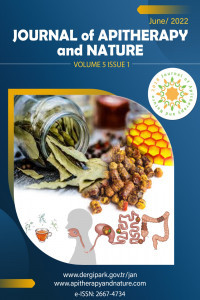Validation Methods for Phenolic Components with RP-HPLC-UV in Various Bee Products
Validation Methods for Phenolic Components with RP-HPLC-UV in Various Bee Products
___
- Arráez-Román, D., Gómez-Caravaca, A.M., Gómez-Romero, M., Segura-Carretero, A. & Fernández-Gutiérrez, A. (2006). Identification of phenolic compounds in rosemary honey using solid-phase extraction by capillary electrophoresis – Electrospray ioniza- tion-mass spectrometry. Journal of Pharmaceutical and Biomedical Analysis, 41 (5) 1648-1656. 2. Balasundram, N., Sundram, K. & Samman, S. (2006). Phenolic compounds in plants and agri-industrial by-products: Antioxidant activity, occurrence, and potential uses. Food Chemistry, 99 (1) 191-203.
- 3. Bertil, M. (2014). The fitness for purpose of analytical methods: A laboratory guide to method validation and related topics. Eurachemistry.
- 4. Bravo, L. (1998). Polyphenols: chemistry, dietary sources, metabolism, and nutritional significance. Nutrition Reviews, 56 (11) 317-333. 5. Can, Z., Yildiz, O., Sahin, H., Akyuz Turumtay, E., Silici, S. & Kolayli, S. (2015). An investi- gation of Turkish honeys: Their physico-chemical properties, antioxidant capacities and phenolic profiles. Food Chemistry, 180, 133–141.
- 6. Cassiano, N.M., Barreiro, J.C., Moraes, M.C., Oliveira, R.V. & Cass, Q.B.(2009). Direct injection of native aqueous matrices by achiral– chiral chromatography ion trap mass spectrometry for simultaneous quantification of pantoprazole and lansoprazole enantiomers fraction. Bioanalysis,1 (3) 577-594.
- 7. Castro, C., Mura, F., Valenzuela, G., Figueroa, C., Salinas, R., Zuñiga, C.M. & Delporte, C. (2014). Identification of phenolic compounds by HPLC-ESI-MS/MS and antioxidant activity from Chilean propolis. Food Research International 64, 873–879.
- 8. Daher, S. & Gülaçar, F.O. (2008). Analysis of phenolic and other aromatic compounds in honeys by solid-phase microextraction followed by gas chromatography–mass spec- trometry. Jounal of Agricultural and Food Chemistry, 56(14), 5775–5780.
- 9. De Villiers, A., Lynen, F., Crouch, A. & Sandra, P. (2004). Development of a Solid-Phase Extraction Procedure for the Simultaneous Determination of Polyphenols, Organic Acids and Sugars in Wine. Chromatograpia, 59, 403–409.
- 10. Escarpa, A. & González, M.C. (2000). Optimization strategy and validation of one chromatographic method as approach to determine the phenolic compounds from different sources. Journal of Chromatography A, 897(1)161-170.
- 11. Escriche, I., Kadar, M., Juan-Borrás, M. & Domenech, E. (2014). Suitability of antioxidant capacity, flavonoids and phenolic acids for floral authentication of honey. Impact of industrial thermal treatment. Food Chemistry, 142, 135–143.
- 12. Fernando Mauro, L. (2009). A Cromatografia Líquida Moderna e a Espectrometria de Massas: finalmente “compatíveis”." Scientia chromatographica Scientia chromatogr, 1(2) 35-61.
- 13. Gómez-Caravaca, A.M., Gómez-Romero, M., Arráez-Román, D., Segura-Carretero, A. & Fernández-Gutiérrez, A. (2006). Advances in the analysis of phenolic compounds in products derived from bees. Journal of Pharmaceutical and Biomedical Analysis, 41 (4) 1220-1234.
- 14. Kader, F., Rovel, B., Girardin, M. & Metche, M. (1996). Fractionation and identification of the phenolic compounds of Highbush blueberries (Vaccinium corymbosum, L). Food Chemistry, 55 (1), 35–40.
- 15. Kim, K.H., Tsao, R., Yang, R. & Cui, S.W. (2006). Phenolic acid profiles and antioxidant activities of wheat bran extracts and the effect of hydrolysis conditions. Food Chemistry, 95 (3) 466–473.
- 16. Kolayli, S., Sahin, H., Can, Z., Yildiz, O. & Sahin, K. (2016). Honey shows potent inhibitory activity against the bovine testes hyaluronidase. Journal of Enzyme Inhibition of Medicinal Chemistry, 31(4) 599-602.
- 17. Maria, R., Esteve-Romero, J. & Carda-Broch, S. (2012). Is it really necessary to validate an analytical method or not? That is the question. Journal of Chromatography A, 101-109.
- 18. Marcucci, M.C. & Bankova, V. (1999). Chemical composition, plant origin and biological activity of Brazilian propolis Current Topics in Phytochemistry, 12(2) 115-123.
- 19. Ribani, M., Collins, C.H. & Bottoli, C.B. (2007). Validation of chromatographic methods: evaluation of detection and quantification limits in the determination of impurities in omeprazole. Journal of Chromatography A, 1156 (1) 201-205.
- 20. Seraglio, S.K.T., Valese, A.C., Daguer, H., Bergamo, G., Azevedo, M.S., Gonzaga, L.V. & Costa, A.C.O. (2016). Development and validation of a LC-ESI-MS/MS method for thedetermination of phenolic compounds in honeydew honeys with thediluted-and-shoot approach. Food Research International, 87, 60-67.
- 21. Tomás Barberán, F.A., Martos, I., Ferreres, F., Radovic, B.S. & Anklam, E. J. (2000). Identification of flavonoid markers for the botanical origin of Eucalyptus honey. Journal of Agricultural Food Chemistry, 48(5) 1498-1502.
- Yayın Aralığı: Yılda 2 Sayı
- Başlangıç: 2018
- Yayıncı: Oktay YILDIZ
Cell-based Cytotoxicity Methods
Albandri ALFRAİDİ, Theara CENDİ FAGUNDES
Atiye DEGIRMENCI, Mehtap ER, Gulsum Merve TURKUT, Gulsah OKUMUS
Ali Timucin Atayoglu, Fang Zhu
Journal Of Apitherapy And Nature .
Synthesis and Applications of Carbon Dots from Food and Natural Products: Review
The Antihelminth Effect and Economic Efficiency of Clover and Absinth
Validation Methods for Phenolic Components with RP-HPLC-UV in Various Bee Products
